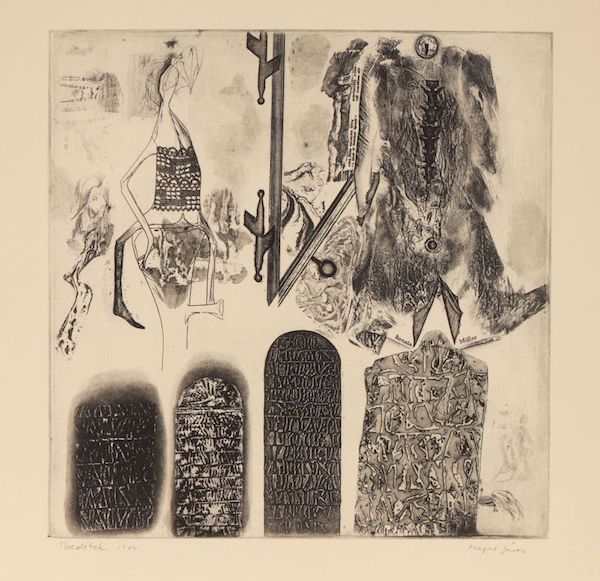Biography
From 1947 to 1950 he attended Álmos Jaschik's drawing school. In 1950-1952 he was a student at the High School of Fine Arts, his teacher was Andor Kántor. In 1952 he enrolled at the Hungarian Academy of Fine Arts, where his teacher was Béla Bán. Major was expelled from the college in 1954. For the next two years he worked at the Orion factory. He drew scenes of working life in the mood of the time. In 1956 Koffán took him back to the Graphic Arts Department, and he graduated. In 1967 he recalled: 'I was a painting student at the college until I was expelled, but that wasn't the interesting thing. It was the fact that after a year I was accepted back into the grafi cai department. I became a grafikus by accident? Now I see it couldn't have been any other way. I haven't painted since." Major's first large-scale work was The Hanged Man, made in early 1957, which was based on the lynchings of 1956 in Republic Square.
After graduating from college, he turned with great interest to the technical renewal of etching. Cynthia's Duck (1960) marks a turning point in his oeuvre. The technically neat elements are composed of elements engraved, etched, etched, watercolored, water-mixed, and chased in aquatint on a sheet of iron plate, as well as a piece of material printed on a soft ground. In the painting of the period, he transferred the techniques of the so-called "retouching" or "cupping" (see Max Ernst) to etching, in such a way that each element of the picture was worked on separately, and even with different techniques, one engraved, the other scratched or etched. In creating independent units within the picture, he followed the Pop Art practice of image-making, although in 1960 he could not have been familiar with the work of the great artists of the movement. It was through technical analysis that he arrived at The Memory of Móric Scharf (1966), a major work of the period. Originally, Eszter Solymosi was to have been the central figure, but Major later reworked her. He found the scene that has since been the most important inspirational motif throughout his work: the cemetery. Also in 1966, the 'other main work', The Bible-bearer Washes, was completed, which for many years was perhaps Major's best-known work. In 1969, Major's one-man protest 'Vasarely go home' took place at the opening of Victor Vasarely's exhibition in Budapest. In 1976, Éva Buchmüller and their children left the country following the emigration of the Fisherman's Theatre. Major stays at home, his private life collapses, followed by an artistic and psychological crisis, most of his works are destroyed and he himself is psychiatrically treated.
He has been making gravestone photographs since the early 1970s. Initially, he was only interested in curiosity. The objective shot of the gravestone itself was interesting because it was either grotesque or too sweet to attract attention. There were also times, however, when a carefully chosen point of view distorted the situation into a grotesque one. Sometimes he highlights the odd object - a ball, a satchel, sometimes the oddities of the caption, which he manipulates with certain omissions, by highlighting passages of text.
His etchings from the 1980s and 1990s are notable for the artist's increasing fascination with boldly erotic, sometimes almost pornographic, elements, which, as they appear in the context of the usual cemetery scenes, are accompanied by a certain bizarre, blackly humorous connotation. At the same time, the late prints retrospectively place all the defining features of the oeuvre in a kind of reflexive perspective. After a while, many important artists feel that they have to erect a monument to their own career and to themselves - in Major's case, literally. The late paintings are both a reflection on the memorial character of cemetery art and a reminder of earlier stages in his career, in which the motif of the gravestone is obsessively repeated.

